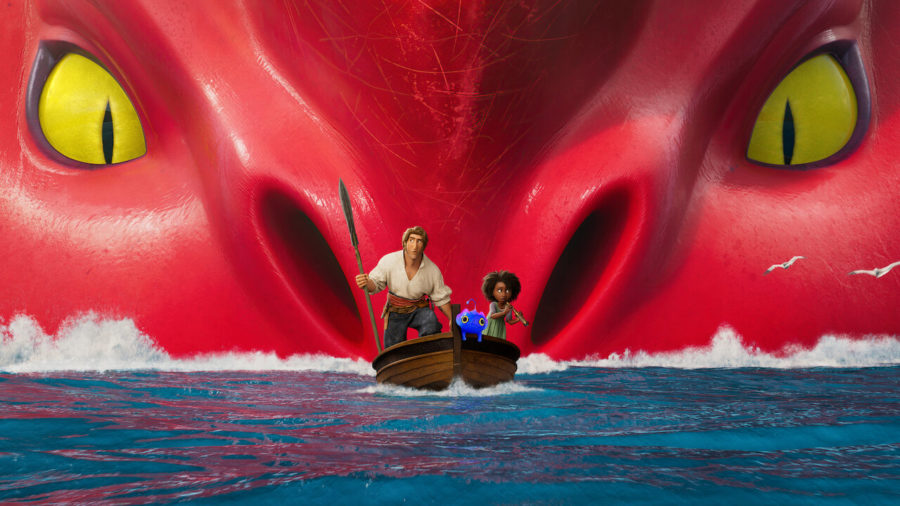Netflix’s “The Sea Beast” offers both unique and familiar elements in its compelling story
Netflix’s animated movie “The Sea Beast” follows young Maisie Brumble as she sets sail to catch sea beasts with Captain Crow and Jacob Holland.
October 28, 2022
Over our fall break last week, I had the chance to catch up on some of the movies that comprise my ever-growing “to watch” list. One of these movies, called “The Sea Beast,” is an animated, family adventure that was released on Netflix over the summer, much to the acclaim of audiences. It made its way onto my list after it reached Netflix’s Top 10 Movies list around mid-July. Beyond seeing this and the movie’s thumbnail, however, I went in completely blind; I wasn’t entirely sure of what to expect when I started watching it. Imagine my surprise, then, when I learned that it was directed and co-written by Chris Williams, the director behind Disney movies like “Moana” and “Big Hero 6.” I figured that I was in for a Disney-esque story with superb animation that would transport me into a new world—I got that and so much more.
Set in a fictitious colonial period where sea monsters exist and hunting them is revered, “The Sea Beast” follows a young orphan girl named Maisie Brumble (Zaris-Angel Hator) who desperately longs to be a hunter. She stows away on the finest monster-hunting ship of them all, The Inevitable, whose legends and stories she is already familiar with. Maisie finds herself among the likes of Captain Crow (Jared Harris), a hardened sea veteran who’s after the most menacing beast in the ocean: the Red Bluster, and the famed Jacob Holland (Karl Urban), the most capable, swashbuckling hunter who grew up on this ship. As they set out to sea to track down the Red Bluster, the characters are forced to decide who the real beasts are: the sea creatures or themselves.
Among the many features of this movie, the water animation particularly stands out. It manages to be hyper-realistic; the way in which the ocean naturally ripples, flows and splashes, when something lands in it is amazingly lifelike. The water even intricately stained and dried on the wooden ship, becoming more visible when the seawater sloshed onboard and then slowly dried under the sun. Unsurprisingly, it was similar to the kind of water animation featured in recent Disney films “Moana” and “Raya and the Last Dragon.”
Similarly, the effort put into the human character design was evident throughout, especially in the character’s faces and their attire. The exceptional detail of many of the characters’ faces was reminiscent of those from a slew of animated Disney movies, such as “Encanto,” “Frozen” and “Tangled.” Their clothing was also painstakingly crafted in a way that felt similar to other animated films of our era; however, it was also stylized to the time period of the movie, with its faded pirate shirts and jackets, worn-in boots and large belts holstering swords and firearms. One of the most interesting aspects of the movie is that this pirate aesthetic is uniquely reinforced by the movie’s dialogue; the characters tend to speak in a sort of old-English manner where words like “my” and “those” are replaced with “me” and “them,” and words like “ye” and “ain’t” are interspersed throughout.
I was shocked to see the design for some of the creatures, like the Red Bluster and Maisie’s “pet” called Blue, because they didn’t seem to fit with the rest of the high quality animation. They appear as almost gelatinous and rubbery blobs of their namesake colors, resembling watery claymation rather than contemporary software-generated figures. It was truly bizarre to see these creatures interact with the animation styles of the water and human characters, almost akin to watching two different animated movies mashed into one. This isn’t to say that their animation was bad by any means—it was actually quite clean and vivid—but rather that I find it hard to see why the animators would make this stylistic choice when they clearly could have done otherwise.
However, it is this mix of the common and the uncommon features that I feel makes it a worthwhile watch. And while some may say that certain aspects of the story and some design elements have been plucked from the “How to Train Your Dragon” franchise, I still think that “The Sea Beast” has plenty to offer. With Williams at the helm, you can certainly expect to have top-tier animation, an enthralling plot and a wholesome message at the movie’s end. Since this isn’t a Disney film, there may have been more of a creative license to experiment with the dialogue, creature design and the plot structure. The surprising climax to the movie—that I won’t give away—that made an interesting point, especially for a kids movie. So, if you’re interested in a visually appealing, mostly lighthearted high seas adventure, then I’d encourage you to check out “The Sea Beast,” currently streaming on Netflix.


